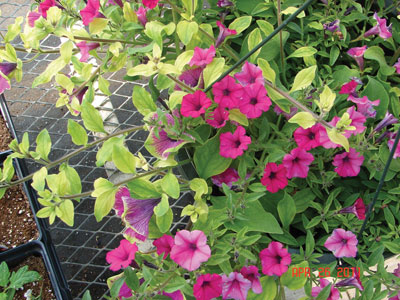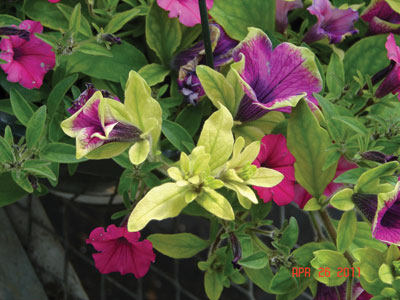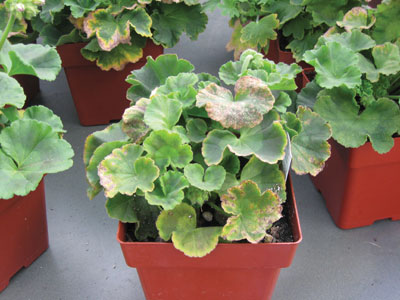
Features
Fertilizer
Inputs
Growing Points: Effectively monitoring pH and EC
March 21, 2012 By Dr. Mohyuddin Mirza
As you sow, so shall you reap: this is an old adage but always very appropriate for the growers.
As you sow, so shall you reap: this is an old adage but always very appropriate for the growers.
 |
|
 |
|
| Fig. 1 photos. These pictures were taken last April, and the diagnosis was iron/manganese deficiency, likely due to alkaline pH in the growing media. | |
 |
|
| Fig. 2 photo. The symptoms of iron toxicity first appear on lower leaves and can quickly spread to the entire plant, rendering the plants unsalable. Plants at this stage would not recover because the damage is irreversible. Advertisement
|
But as we all know, it is not just the “sowing” and the “reaping.” There are several things before and after sowing and they include choice of a good growing medium, germination, transplanting, watering and fertilizing, disease and insect control and many other crop management practices.
There is no doubt that the end product for sale is dependent on what you have sown and how well you looked after them. The laws that govern the growth and development of plants are well known to growers. They are taught and reviewed in workshops and conferences and published frequently, but even then problems occur because it is the people who create the problems, not the plants. March is a good time to remind growers of plant problems related to pH and EC that appear in April.
See Fig. 1 photos. These pictures were taken on April 26 of last year, and the diagnosis was iron/manganese deficiency, likely due to alkaline pH in the growing media. Most of the time iron and other trace elements are adequate in the rootzone. The symptoms were visible at this stage when hanging baskets were ready for sale.
The lower picture is a good example of top growth showing yellowing but with the veins remaining green. With confidence one can conclude it is iron/manganese deficiency.
ADJUSTMENTS THIS MONTH WILL HELP PREVENT APRIL PROBLEMS
■ There are always two questions: why did it happen, and how do I correct the problem quickly? What happens in March is important to understand, so that you can have good growth in April and beyond.
Why did these symptoms appear and why at this stage? The starting point is the growing medium and its pH. The suppliers provide information on “guaranteed” pH at the starting point, but as the plants grow and are watered and fertilized, different organic and inorganic chemicals build up in the rootzone and the pH changes to the acidic side or the alkaline side.
Bicarbonates in water and acidity or alkalinity of fertilizers are two major factors that influence the pH of the growing media when plants are growing and there is good root activity. What happened in the case mentioned earlier was that the pH was changing to the alkaline side and the grower was not monitoring it on a regular basis. A basic understanding of pH is required.
What is pH? This is a measurement of the acidity or alkalinity (base) of a solution. When substances dissolve in water, they produce charged molecules called ions. Acidic water contains extra hydrogen ions (H+) and basic water contains extra hydroxyl (OH-) ions.
Note that pH is measured on a scale of 0 to 14. Neutral water has a pH of 7. Acidic water has pH values less than 7, with 0 being the most acidic. Likewise, basic water has values greater than 7, with 14 being the most basic.
PH LEVELS CONSTANTLY CHANGE DURING THE SEASON
A change of one unit on a pH scale represents a tenfold change in the pH, so that water with pH of 6 is 10 times more acidic than water with a pH of 7, and water with a pH of 5 is 100 times more acidic than water with a pH of 7. That is the reason it takes longer to adjust the pH of the growing medium. The pH levels constantly change during the duration of the crop and must be monitored regularly. Growers must also know the optimum ranges of pH for the crops they are growing.
Knowing the starting point? The following things should be known by growers and managers:
- Growing medium, its physical and chemical quality, including air porosity and water holding capacity. Not only should they know them, but they should also know what they mean and how these parameters are going to change as the plants are growing.
- Volume of the container. The smaller the container, the smaller is the air porosity. Percent volume air space can vary from one per cent in smaller plug trays, to 20 per cent in six-inch pots and that means watering has to be adjusted accordingly.
- Growers must know the water quality, especially the bicarbonates level and also the sodium level. I have seen high sodium levels cause major problems for bedding plants. Bicarbonates have major influence on the pH of the growing medium.
- Know about the plants you are growing. There are plants considered “iron efficient,” also referred to as Geranium Group plants. This means that pH below 5.5 in the rootzone may cause excess iron in the leaves, and thus toxicities. The Fig. 2 picture exemplifies this aspect of iron efficiency.
Iron-inefficient plants include Petunia Group plants. These plants show iron deficiency quickly when the pH changes to the alkaline side, or if not enough fertilizer is supplied. That is why a pH of between 5.5 to 6.2 is recommended.
MAKING ADJUSTMENTS
- Monitor pH and EC on a regular basis. My recommendation is to monitor two to three times a week and plot the results. Be sure to display these graphs where you can see them on a daily basis. If you are using a computer, put a sticky note on the screen.
- Take action when a trend is evident that pH is going high or low. Don’t wait until symptoms have appeared!
- If pH is going low, then add potassium bicarbonate, which is soluble and can be applied through an injector. Don’t mix it with fertilizers. Remember it may take up to three applications to turn the pH around.
- If pH is going higher, then acidify your nutrient solution. Choose among the three acids wisely. Most growers choose between phosphoric, nitric and sulphuric acid. Plug growers may like to use citric acid. A water quality analysis will help you decide which acid is best suited to your needs.
IN SUMMARY
■ Growers can use ammonium-based fertilizers from late March through April for iron-inefficient plants to keep the pH from rising.
The key point is to invest in a good pH and EC meter, calibrate it regularly, and use the information to your advantage to produce a great product for customers. Watch for more in future columns about EC (electrical conductivity) and its management.
Dr. Mohyuddin Mirza can be reached at drmirzagreen@gmail.com with comments, questions or suggestions for future columns.
Print this page